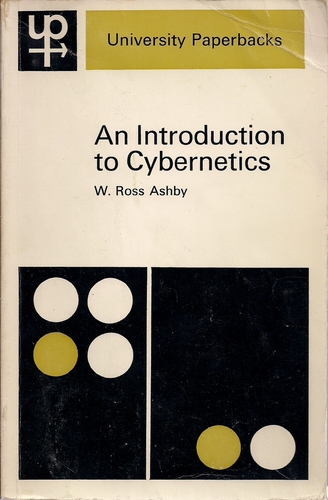W. Ross Ashby: An Introduction to Cybernetics (1957–) [EN, PT]
Filed under book | Tags: · cybernetics, machine, systems theory

“W. Ross Ashby is one of the founding fathers of both cybernetics and systems theory. He developed such fundamental ideas as the homeostat, the law of requisite variety, the principle of self-organization, and the principle of regulatory models. Many of these insights were already proposed in the 1940’s and 1950’s, long before the presently propular “complex adaptive systems” approach arrived at very similar conclusions. Whereas the concepts surrounding the complexity movement are often complicated and confuse, Ashby’s ideas are surprisingly clear and simple, yet deep and universal.
This elegance of thought is illustrated in particular by the present book, which is still the only real textbook on cybernetics (and, one might add, system theory). It explains the basic principles with concrete examples, elementary mathematics and exercises for the reader. It does not require any mathematics beyond the basic high school level. Although simple, the book formulates principles at a high level of abstraction. For more concrete and extensive illustrations of systems principles, you may refer to other books, The Macroscope and The Phenomenon of Science. For a similar abstract, high-level, but technically simple approach, this time to physics, you can check Representation and Change.” (source)
Key words and phrases: entropy, transducer, Markov chain, cybernetics, isomorphic, dynamic system, Black Box theory, equilibrium, cerebral cortex, channel capacity, homomorphism, homeostat, machine of desired, degrees of freedom, ovum, diagram of immediate, logarithmically, Markovian machine, Shannon’s theorem, servo-mechanism
Publisher John Wiley and Sons, 1957
250 pages
An Introduction to Cybernetics (English, 1957)
Introdução à cibernetica (Portuguese, trans. Gita K. Ghinzberg, 1970, added on 2013-8-10)
Sherry Turkle: The Second Self: Computers and the Human Spirit, 20th ed. (1984/2005)
Filed under book | Tags: · artificial intelligence, computing, hacker culture, machine, media culture, psychology, software, things, video games

“In The Second Self, Sherry Turkle looks at the computer not as a “tool,” but as part of our social and psychological lives; she looks beyond how we use computer games and spreadsheets to explore how the computer affects our awareness of ourselves, of one another, and of our relationship with the world. “Technology,” she writes, “catalyzes changes not only in what we do but in how we think.” First published in 1984, The Second Self is still essential reading as a primer in the psychology of computation. This twentieth anniversary edition allows us to reconsider two decades of computer culture—to (re)experience what was and is most novel in our new media culture and to view our own contemporary relationship with technology with fresh eyes. Turkle frames this classic work with a new introduction, a new epilogue, and extensive notes added to the original text.
Turkle talks to children, college students, engineers, AI scientists, hackers, and personal computer owners—people confronting machines that seem to think and at the same time suggest a new way for us to think—about human thought, emotion, memory, and understanding. Her interviews reveal that we experience computers as being on the border between inanimate and animate, as both an extension of the self and part of the external world. Their special place betwixt and between traditional categories is part of what makes them compelling and evocative. (In the introduction to this edition, Turkle quotes a PDA user as saying, “When my Palm crashed, it was like a death. I thought I had lost my mind.”) Why we think of the workings of a machine in psychological terms—how this happens, and what it means for all of us—is the ever more timely subject of The Second Self.”
Keywords: personal computer, Speak and Spell, video games, hacker culture, artificial intelligence, Software Wars, Pac-Man, Marvin Minsky, Merlin, Seymour Papert, tic-tac-toe, Dungeons and Dragons, sprite, Tinkertoys, Sherry Turkle, Joseph Weizenbaum, home computer, computer program, pinball, Space Invaders
Publisher MIT Press, 2005
ISBN 0262701111, 9780262701112
372 pages
PDF (updated on 2014-9-15)
Comments (3)
